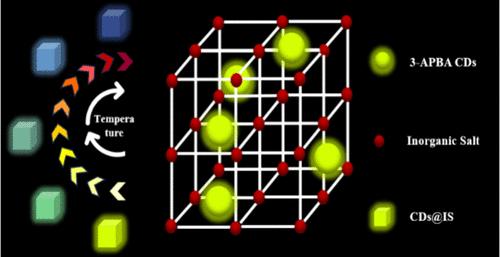用于防伪和温度传感的无机盐诱导碳点双发射余辉
IF 3.9
2区 化学
Q2 CHEMISTRY, MULTIDISCIPLINARY
引用次数: 0
摘要
余辉碳点由于能有效地阻挡背景光的干扰,在传感和防伪方面得到了广泛的研究。本文以间氨基苯基硼酸(m-APBA)和不同种类的无机盐(IS)为原料,通过水热法制备了间氨基苯基硼酸(m-APBA) CDs。当m-APBA cd与CaCl2和MgCl2结合时,可以利用CaCl2和MgCl2聚集能力最强、电荷密度高、结构约束和m-APBA cd的缺陷,实现双发射余辉。获得的CDs@CaCl2具有双模余辉,量子产率为4.81%,寿命为352 ms(延迟荧光)和205 ms(磷光)。CDs@IS的余辉可以同时被紫外光和可见光激发,记录时间分别为8 s和4 s。这种独特的诱导m-APBA CD余辉的方法具有合成简单、成本低、余辉发射可调等优点。此外,CDs@IS在防伪和温度传感方面表现出优异的性能,进一步确立了其实际应用价值。本文章由计算机程序翻译,如有差异,请以英文原文为准。

Dual-Emission Afterglow of Carbon Dots Induced by an Inorganic Salt for Anticounterfeiting and Temperature Sensing
Afterglow carbon dots (CDs) have been extensively studied for sensing and anticounterfeiting because they can effectively block out the interference of background light. In this work, m-APBA CDs are obtained hydrothermally with m-aminophenylboric acid (m-APBA) and different kinds of inorganic salts (IS). When m-APBA CDs are combined with CaCl2 and MgCl2, dual-emission afterglow can be achieved based on CaCl2 and MgCl2 having the strongest aggregation ability, high charge density, structural confinement, and defects with respect to m-APBA CDs. The as-obtained CDs@CaCl2 exhibits a dual mode afterglow with a quantum yield of 4.81% and lifetimes of 352 ms (delayed fluorescence) and 205 ms (phosphorescence). The afterglow of CDs@IS can be excited by both UV and visible light at the same time, which could be recorded for about 8 and 4 s. This unique method of inducing the m-APBA CD afterglow has the advantages of simple synthesis, low cost, and adjustable afterglow emission. Moreover, CDs@IS showed exceptional performance in anticounterfeiting and temperature sensing, further establishing its practical utility.
求助全文
通过发布文献求助,成功后即可免费获取论文全文。
去求助
来源期刊

Langmuir
化学-材料科学:综合
CiteScore
6.50
自引率
10.30%
发文量
1464
审稿时长
2.1 months
期刊介绍:
Langmuir is an interdisciplinary journal publishing articles in the following subject categories:
Colloids: surfactants and self-assembly, dispersions, emulsions, foams
Interfaces: adsorption, reactions, films, forces
Biological Interfaces: biocolloids, biomolecular and biomimetic materials
Materials: nano- and mesostructured materials, polymers, gels, liquid crystals
Electrochemistry: interfacial charge transfer, charge transport, electrocatalysis, electrokinetic phenomena, bioelectrochemistry
Devices and Applications: sensors, fluidics, patterning, catalysis, photonic crystals
However, when high-impact, original work is submitted that does not fit within the above categories, decisions to accept or decline such papers will be based on one criteria: What Would Irving Do?
Langmuir ranks #2 in citations out of 136 journals in the category of Physical Chemistry with 113,157 total citations. The journal received an Impact Factor of 4.384*.
This journal is also indexed in the categories of Materials Science (ranked #1) and Multidisciplinary Chemistry (ranked #5).
 求助内容:
求助内容: 应助结果提醒方式:
应助结果提醒方式:


